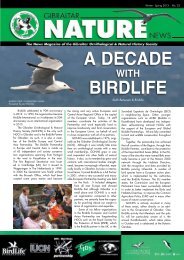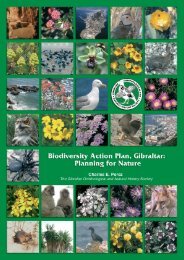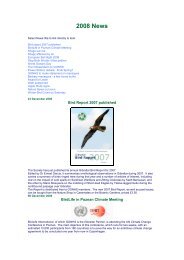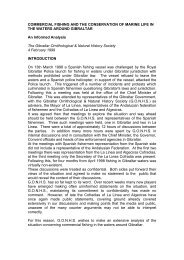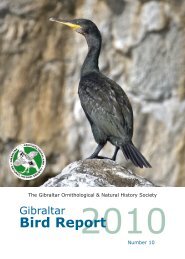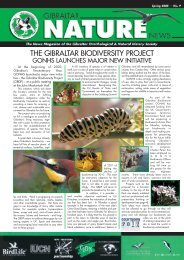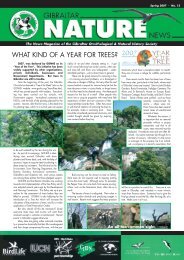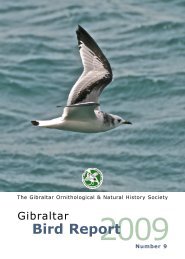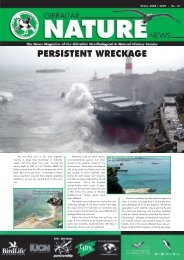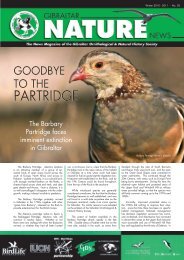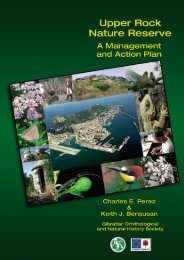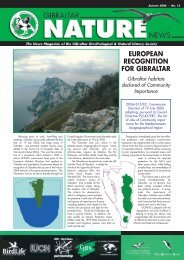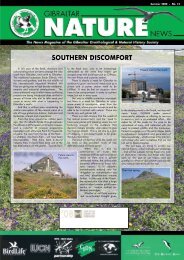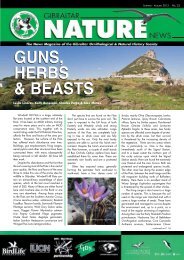ure News 11 - Gibraltar Ornithological & Natural History Society
ure News 11 - Gibraltar Ornithological & Natural History Society
ure News 11 - Gibraltar Ornithological & Natural History Society
Create successful ePaper yourself
Turn your PDF publications into a flip-book with our unique Google optimized e-Paper software.
Bougainvillea Bougainvillea spectabilis, consists of<br />
a Mediterranean scrub and pine Pinus pinaster<br />
woodland, with typical scrub species including<br />
notably the lentisc Pistacia lentiscus.<br />
The scrub and woodland soon give way to<br />
open ground, the beginnings of many square<br />
kilometres of mountain continuing southward into<br />
the Rif to Chefchauoen and beyond.<br />
The open vegetation is largely low and<br />
degraded, due to intense grazing by goats, except<br />
in several pockets near the scattered villages,<br />
where wheat is grown and where fields with wild<br />
flowers provide spectacular colour. The vertical<br />
cliffs are relatively protected from grazing, and<br />
here a number of plant species thrive, including<br />
the Giant Tangier fennel, Ferula tingitana, the saxifrage<br />
Saxifraga globulifera, and the campion<br />
Silene andryalifolia, which was the focus of the<br />
GIBMANATUR work in this area. One particularly<br />
attractive flower of the mountain is Erodium<br />
cheilanthifolium which forms tight carpets in some<br />
exposed areas.<br />
The mountains have an interesting community<br />
of birds. The main species encountered are the<br />
Black Wheatear and the characteristic Moussier’s<br />
Redstart, with Thekla Lark also being present.<br />
Raptors include Long-legged Buzzard and Lanner,<br />
while Ravens are always a feat<strong>ure</strong>.<br />
Another typical mountain bird, the Chough, is<br />
common and can be seen in flocks circling the<br />
hillsides or feeding on the ground. Curiously,<br />
despite the relatively low altitude, the Alpine<br />
Chough is also present throughout the year, and<br />
although less so than the Chough, is still common<br />
and a likely breeder here.<br />
The area as a whole provides stunning views<br />
in all directions, including northwards towards<br />
<strong>Gibraltar</strong> and the Strait.<br />
Nestled among the hillsides are a number of<br />
communities and traditional activities, which<br />
include grazing of livestock and lime production.<br />
These contrast with what is becoming a major<br />
industry in the area, the quarrying of rock, which<br />
is threatening some interesting landscapes and<br />
habitats.<br />
Echium boissieri, El Jbel<br />
Moussier’s Redstart<br />
Paronychia capitata, El Jbel<br />
Traditional production of lime<br />
Polygonum maritimum, Martil<br />
NOTES & NEWS<br />
MORE HYMENOPTERA IN<br />
SECTION’S SCOPE<br />
The GONHS Invertebrate Section is always busy.<br />
Recently, Rhian Guillem has made enormous<br />
headway in the study of the ants of <strong>Gibraltar</strong>,<br />
with the Rock’s myrmecological fauna now<br />
largely catalogued and a fine reference collection<br />
prepared. Ants belong to the order<br />
Hymenoptera, which includes bees and wasps.<br />
Now, Rhian is expanding her interest to include<br />
other groups within this enormous order. She<br />
has begun to collect and identify Mutillidae<br />
(Velvet Ants) and Chrysididae (Rubytail Wasps)<br />
and is beginning to expand into other families.<br />
Anybody wishing to know about Hymenoptera<br />
in <strong>Gibraltar</strong> should contact Rhian Guillem<br />
(ants@gonhs.org). Keith Bensusan (kbensusan@gonhs.org)<br />
can provide additional information<br />
on the activities of the Invertebrate section.<br />
TORRES RETURNS<br />
Jose Luis Torres is an entomologist from the<br />
neighbouring town of La Linea. After an inactive<br />
few years, ‘Pepe’ is now working in the field of<br />
entomology (the study of invertebrates) once<br />
again, following his retirement. Pepe began collecting<br />
and studying butterflies and moths in the<br />
1970s, but eventually moved on to beetles which<br />
have remained his passion. An expert field<br />
worker, Pepe does not limit his collecting to<br />
Coleoptera. Recently, he has made significant<br />
finds of Hemiptera (true bugs) and ants. Pepe<br />
has a solid friendship with Charlie Perez, Rhian<br />
Guillem and Keith Bensusan of the GONHS<br />
Invertebrate section and visits them regularly on<br />
the Rock. During his visits, Pepe frequently supplies<br />
them with interesting specimens for study<br />
and invaluable information on how to find<br />
species that are rare or difficult to locate.<br />
Working collaboration between Pepe and<br />
GONHS members has already resulted in publications<br />
in entomological journals and we<br />
expect many more.<br />
TO JOIN... and support our<br />
work send your subcription<br />
to GONHS, PO Box 843,<br />
<strong>Gibraltar</strong> with your name<br />
and address, or fill in the<br />
on-line form at:<br />
www.gonhs.org<br />
GIBRALTAR NATURE NEWS<br />
15



